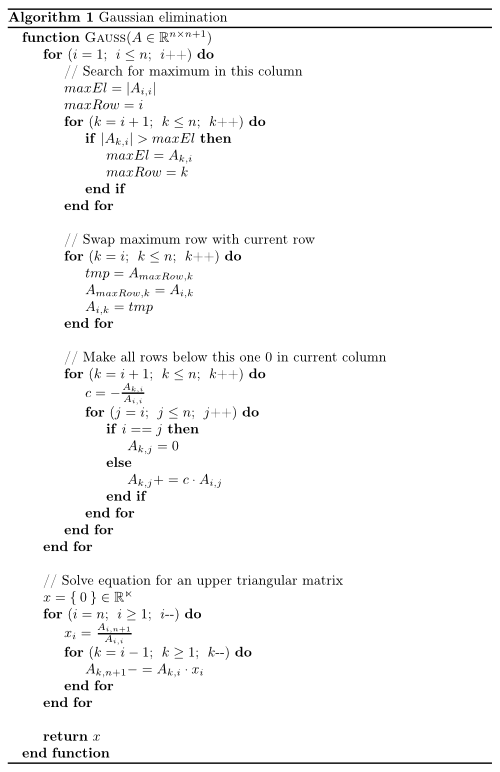Please note that you should use LU-decomposition to solve linear equations. The following code produces valid solutions, but when your vector changes you have to do all the work again. LU-decomposition is faster in those cases and not slower in case you don't have to solve equations with the same matrix twice.
源自於 https://martin-thoma.com/solving-linear-equations-with-gaussian-elimination/
Suppose you have a system of linear equations and variables :
All factors for can be written in one matrix and all can be written as a vector . You combine all in the same way to a vector .
So you can write the system of equations as:
How Gaussian elimination works ¶
First, you write and in an augmented matrix :
On this matrix you may make exactly three operations:
- Swap rows
- Add one row onto another
- Multiply every factor of one row with a constant
You want to get a triangular matrix. So you subsequently eliminate one variable from the system of equations until you have a matrix like this:
It's actually quite simple to get this form:

C++ Code ¶
#include <iostream>
#include <cmath>
#include <vector>
using namespace std;
void print(vector< vector<double> > A) {
int n = A.size();
for (int i=0; i<n; i++) {
for (int j=0; j<n+1; j++) {
cout << A[i][j] << "\t";
if (j == n-1) {
cout << "| ";
}
}
cout << "\n";
}
cout << endl;
}
vector<double> gauss(vector< vector<double> > A) {
int n = A.size();
for (int i=0; i<n; i++) {
// Search for maximum in this column
double maxEl = abs(A[i][i]);
int maxRow = i;
for (int k=i+1; k<n; k++) {
if (abs(A[k][i]) > maxEl) {
maxEl = abs(A[k][i]);
maxRow = k;
}
}
// Swap maximum row with current row (column by column)
for (int k=i; k<n+1;k++) {
double tmp = A[maxRow][k];
A[maxRow][k] = A[i][k];
A[i][k] = tmp;
}
// Make all rows below this one 0 in current column
for (int k=i+1; k<n; k++) {
double c = -A[k][i]/A[i][i];
for (int j=i; j<n+1; j++) {
if (i==j) {
A[k][j] = 0;
} else {
A[k][j] += c * A[i][j];
}
}
}
}
// Solve equation Ax=b for an upper triangular matrix A
vector<double> x(n);
for (int i=n-1; i>=0; i--) {
x[i] = A[i][n]/A[i][i];
for (int k=i-1;k>=0; k--) {
A[k][n] -= A[k][i] * x[i];
}
}
return x;
}
int main() {
int n;
cin >> n;
vector<double> line(n+1,0);
vector< vector<double> > A(n,line);
// Read input data
for (int i=0; i<n; i++) {
for (int j=0; j<n; j++) {
cin >> A[i][j];
}
}
for (int i=0; i<n; i++) {
cin >> A[i][n];
}
// Print input
print(A);
// Calculate solution
vector<double> x(n);
x = gauss(A);
// Print result
cout << "Result:\t";
for (int i=0; i<n; i++) {
cout << x[i] << " ";
}
cout << endl;
}
You can call it like this:
./gauss.out < 3x3.in
1 2 3 | 1
4 5 6 | 1
1 0 1 | 1
Result: 0 -1 1
Python code ¶
#!/usr/bin/env python
# -*- coding: utf-8 -*-
def pprint(A):
n = len(A)
for i in range(0, n):
line = ""
for j in range(0, n+1):
line += str(A[i][j]) + "\t"
if j == n-1:
line += "| "
print(line)
print("")
def gauss(A):
n = len(A)
for i in range(0, n):
# Search for maximum in this column
maxEl = abs(A[i][i])
maxRow = i
for k in range(i+1, n):
if abs(A[k][i]) > maxEl:
maxEl = abs(A[k][i])
maxRow = k
# Swap maximum row with current row (column by column)
for k in range(i, n+1):
tmp = A[maxRow][k]
A[maxRow][k] = A[i][k]
A[i][k] = tmp
# Make all rows below this one 0 in current column
for k in range(i+1, n):
c = -A[k][i]/A[i][i]
for j in range(i, n+1):
if i == j:
A[k][j] = 0
else:
A[k][j] += c * A[i][j]
# Solve equation Ax=b for an upper triangular matrix A
x = [0 for i in range(n)]
for i in range(n-1, -1, -1):
x[i] = A[i][n]/A[i][i]
for k in range(i-1, -1, -1):
A[k][n] -= A[k][i] * x[i]
return x
if __name__ == "__main__":
from fractions import Fraction
n = input()
A = [[0 for j in range(n+1)] for i in range(n)]
# Read input data
for i in range(0, n):
line = map(Fraction, raw_input().split(" "))
for j, el in enumerate(line):
A[i][j] = el
raw_input()
line = raw_input().split(" ")
lastLine = map(Fraction, line)
for i in range(0, n):
A[i][n] = lastLine[i]
# Print input
pprint(A)
# Calculate solution
x = gauss(A)
# Print result
line = "Result:\t"
for i in range(0, n):
line += str(x[i]) + "\t"
print(line)


沒有留言:
張貼留言